Last Saturday, I finally tried the brand-new lightweight pack that I intend to use for the seven-day Grand to Grand Ultra, when we competitors have to carry all our stuff for the week—all food, clothing, and sleeping and safety gear—on our backs. The fit of the pack is pretty darn important. Yet I had waited until now, seven weeks before the event, to load mine up and take it on a test run.
I’ve been procrastinating on this race prep, something I tend to do when I care so much about something that I don’t start it unless and until I believe it’ll work out and I can do it just right. It’s procrastination linked to perfectionism. This pack has been sitting in its plastic wrapping in my closet all summer, and I told myself I was waiting to train with it because I don’t want to wear it out, which is partly true. I want it to be nearly new for the race week.
But truthfully, I don’t want to discover that it’s uncomfortable or disappointing in some way. I don’t want it to fail me, because I really don’t have a backup plan for a pack. This brand, Raidlight, comes from Europe and takes a long time to ship, and returns are difficult to handle. I’ve tried other brands that make ultralight packs for fastpacking, like Ultimate Direction, and don’t like them. So this one feels like my only good option.
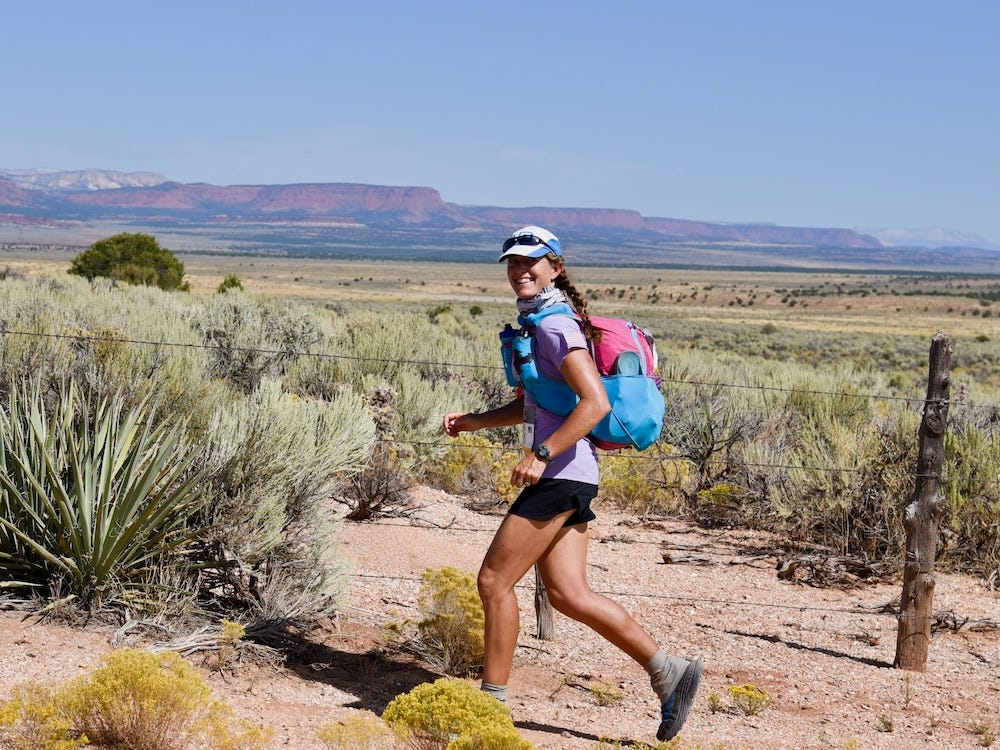
I used a version of this same pack five years ago, the last time I did the Grand to Grand. The pack fit great—it hugged my body, no bounce—and I managed to make everything fit like jigsaw pieces. With my water bottles full, it weighed about 22 pounds.
And yet, it failed me during the event’s first day. As I ran through the desert, I heard a pop and felt the tension loosen around my ribcage. The wire cable system that makes the pack snug by turning a dial had broken, and suddenly, my pack was bouncing like a saddlebag on a bronco.
I had to think fast to save my race—I couldn’t finish the 170 miles with this bouncing on my back. I imagined getting a rope or belt to cinch down the pack around my torso, but I hadn’t brought any rope or belt.
The Grand to Grand Ultra is self-supported. If you forget to bring something you need, or if your equipment malfunctions, you have to make do and troubleshoot. They provide water and communal tents, that’s all.
Thankfully, my shorts had a drawstring. While other competitors ran past me, I pulled the drawstring out of my waistband and carefully threaded it through the cable system’s holes. I laced it up like a shoe. It worked! The pack fit snugly around my torso again, and fortunately, the elastic on my shorts held them up without the drawstring.
I finished that first stage behind other women, in part because of that delay to fix my pack, but I made up time in the subsequent days and ultimately finished first female, tenth overall.

So now I’m back to pack training—better late than never. I got out my new Raidlight pack (which, since it’s unisex, thankfully is designed with the neutral colors of black and white, not the ridiculous Easter egg colors of the female-specific pack of 2019) and filled it with extra water and various pieces of gear and pantry items to get the weight to about 15 pounds. Then I headed out on a trail for a test run.
Running with a pack is so humbling. Even with only 15 pounds—lighter than the 20 or so it’ll be when I start the race with all the food I’ll need—I felt like I could barely pick up my feet. I also felt off balance, my body pitching forward at the waist to counter the weight pulling me back.
I warmed up with hiking and then cautiously broke into a slow run, trying to maintain good posture and an engaged core to stay upright. Running with pack weight makes for a shorter, slower stride. I imagined running through the sand we’ll face in the desert, and I tried to run with as light of a foot strike as possible to avoid sinking in the sand. But it’s hard to feel light, agile, and quick with the dead weight of 15 or more pounds on your shoulders.
All the weight hangs on the shoulders, because these packs don’t have a waist belt to transfer weight to the hips, like a regular backpack. These fastpacks are designed like hydration packs, and the result is a more runnable, snug fit. But it also means that it’s all on your shoulders.
Right away, my shoulders and the base of my neck started to feel tired. “Of course they do,” I told myself, “I need to adapt. Get used to it.”
But a couple of miles later, a one-sided pressure point developed near my left shoulder. I shifted my pack around but couldn’t make it go away. It felt like something pushing and hurting a particularly sensitive spot on my left collarbone. These kinds of pressure points can turn into “hot spots” of pain that are more troublesome than blisters. It wasn’t chafing as much as pinching. I started to fantasize about getting a pad to sew under my pack strap as a cushion. Or maybe I’ll take an extra pair of socks and fold them under the pack strap there.
The fact that I was thinking—obsessing—about this hot spot for several miles meant I had a problem that needs fixing, and fix it I will, somehow.
I tried to relax into the circumstances, cultivating patience for the slow pace. Given the extra weight, desert heat, and sand during the event, I need to mentally prepare for extra-slow running with hiking mixed in, averaging at best about four miles per hour.
But during this training run, anxiety disrupted any deliberate effort at patience. I kept thinking back to 2012 and 2014, the first two times I did this self-supported stage race, and in those years, I had pack trained early enough and well enough in the summer that by the first weekend in August, I was fit and ready to run a 50K race with full pack weight as a peak training run for the Grand to Grand. This year, I’m far behind that readiness. And I’ve discovered this hot-spot problem.
I finished my run after two hours, covering eight miles in that time, discouraged but resolved. “It is what it is,” I told myself. I will troubleshoot the pressure point by re-packing the pack in a way that, I hope, alleviates the problem spot. And I will do what I can—make the most of what I’ve got—for training in the next five weeks, before tapering.
So I’m not as trained as I was in years past. So what? I’m doing it anyway.
I toyed with the concept of the pack and the word itself. It’s not just a backpack. It also can mean a group, like a wolf pack or a bunch of competitors, and this time I’ll likely be mid-pack or back-of-the-pack, so be it. It’s an activity, packing. Like packing to go on a journey, which I want to do. Or packing it in, i.e. quitting, which I don’t want to do. Or packing a punch, like a force of nature, which this pack seems to do to my shoulders.
What a privilege or folly it is that I can spend so much mental and physical energy—and the bulk of this newsletter post—thinking about this pack and its meaning. But it’s one of the most appealing and challenging aspects of this event—carrying all you need for the week and living a minimalist lifestyle. It’s a big reason why I’m doing the Grand to Grand again, to remind myself that I can get by on the bare essentials.
Fifteen years ago, in 2009 when I was 40, I embarked on the greatest adventure of my life. With my husband and two kids, then 11 and 8, we left home, work, and school, raided our savings and rented out our house, and hit the road for ten months of round-the-world nomadic living and roadschooling, ultimately staying in 83 places on five continents. One of the best parts was my pack—my soft-sided suitcase with backpack straps—into which I fit all the clothes, shoes, and toiletries I needed for a year. We made a rule of taking only one suitcase and one daypack each (plus we had a communal fifth bag with tech gear and school supplies). We told the kids, when they wanted to buy things, “If you get it, you carry it.” They had to carry and be responsible for their own stuff, too. (Our eight-year-old’s bag—the blue one pictured below—had roller wheels to make it manageable for him.)
I discovered I can wear pretty much the same thing every day and not care much about my appearance, and I really only need running shoes and sandals.
I think about that traveling-light mode—how liberating it felt in its simplicity, stripping life down to the essentials on a tight budget—and it renews my excitement and resolve for the Grand to Grand Ultra. It want to leave my regular life with all its materialistic comforts for the week and get back to nature and reconnect with self-reliance.
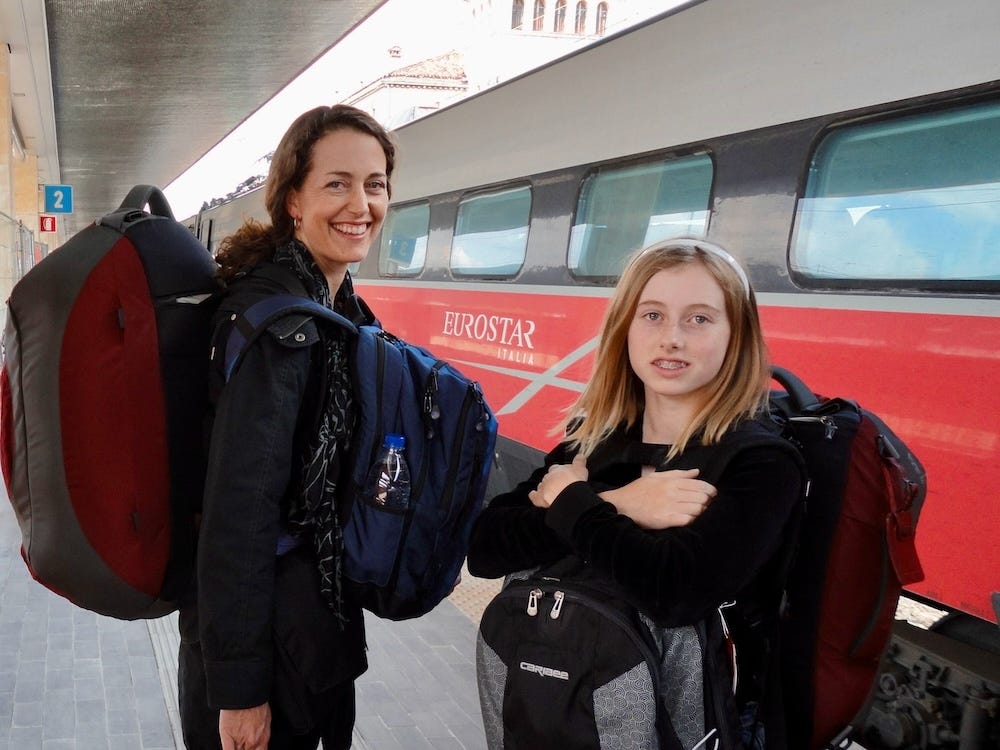
With that in mind, I’ll make peace with my pack’s weight and troubleshoot the pressure point. I’ll also make peace with my less-than-optimal training and have faith that experience will compensate for lack of fitness. I am older and slower but wiser. And I’m not in it to win it. I’m in it to live it—to soak it all up and feel it all fully. It’ll take the time it takes, step by step, stage by stage.
Win this Patagonia duffle!
Speaking of duffles that double as packs, I am raffling off a really nice one—this Patagonia 55L Black Hole Duffel (pictured here in its carrying case; it’s nice and roomy and durable, as you can see on its product page).
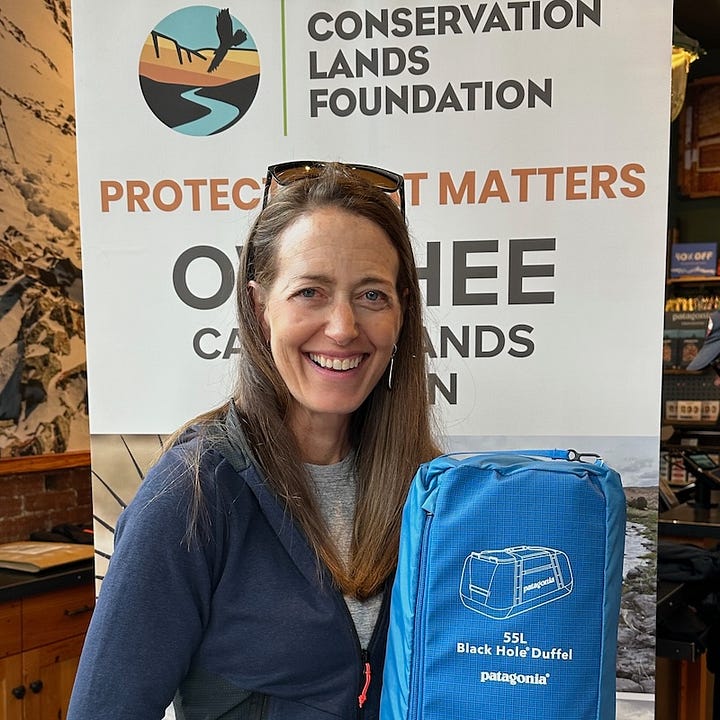
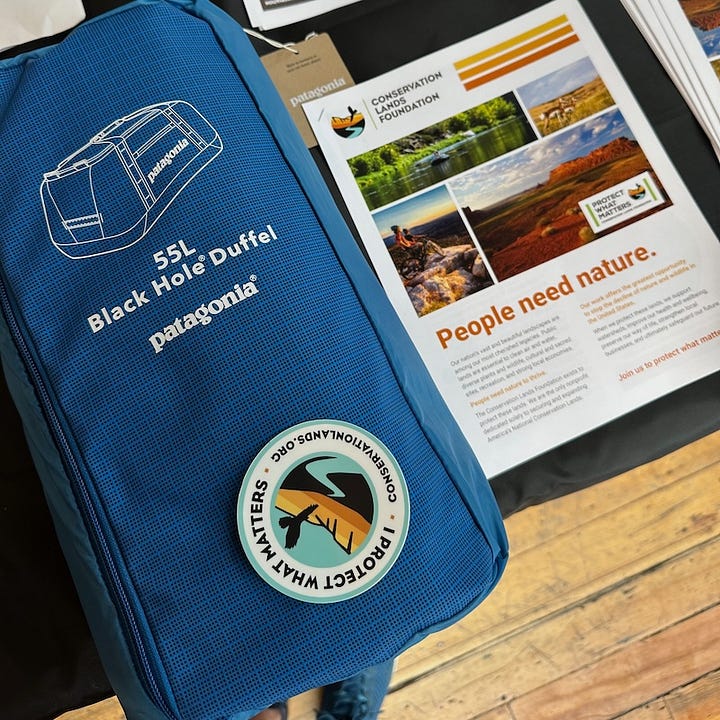
Yesterday, I spent a couple of hours in the Patagonia store in Telluride with a representative of the nonprofit Conservation Lands Foundation, talking to shoppers and visitors about public lands protection. As you may know from my last two posts, I have a fundraising campaign to raise funds and awareness for the Conservation Lands Foundation, which is the only nonprofit dedicated to protecting and expanding the National Conservation Lands managed by the Bureau of Land Management.
The Patagonia store generously gave this new duffel to me to give away as an incentive to donors. So, starting today (August 7), I will collect the names of the next 10 donors to my fundraiser and then choose one of their names at random to win this duffel, and then I’ll have it shipped to the winner.
Please click through to my fundraiser using the button below and learn about it, and I hope you will consider making a donation and getting a chance to win the Patagonia prize. I have raised $950 from 14 donors so far, which means I’m nearly one-fifth of the way to my goal of raising $5000 between now and September 28, when I finish the Grand to Grand.
Two recommended posts and the best movie about old people
Coach Mario Fraioli discusses acceptance, and being slower, in his newsletter this week. “All too often as athletes and coaches we have a tendency or inclination to train where we want to be, or where we think we should be, or even where we were a few months ago, and not necessarily where we are at the time. We end up getting ahead of ourselves and inevitably end up in a cycle of frustration, stalled progress, injury, or worse. If nothing else, I’m committed to being where I am as I work toward getting where I want to be. … I can’t rush any of it. I’ll get there when I get there.”
As a followup to my newsletter’s post last week about heat training, I recommend this post by
on training in the heat/humidity and taking care of yourself:
And lastly, I watched a wonderful movie a few nights ago. I don’t watch as many feature-length films these days, preferring streaming shows broken into episodes. But I stumbled upon Thelma, a new release available through Amazon Prime. It’s about a spunky 93-year-old woman who gets out and gets even, and it plays with the action-movie genre in really funny ways. It also casts my favorite neurotic indie film star, Parker Posey, whom I haven’t seen in a film in over a decade. Having spent many years visiting my mom in assisted living before she passed away in 2022, I can say this film gets the dialogue, mannerisms, and decline of old people just right. It’s as heartwarming as movies get, but also really smart, not saccharine.

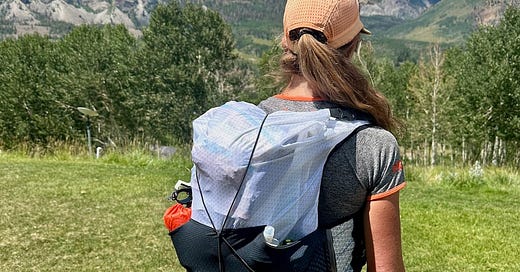


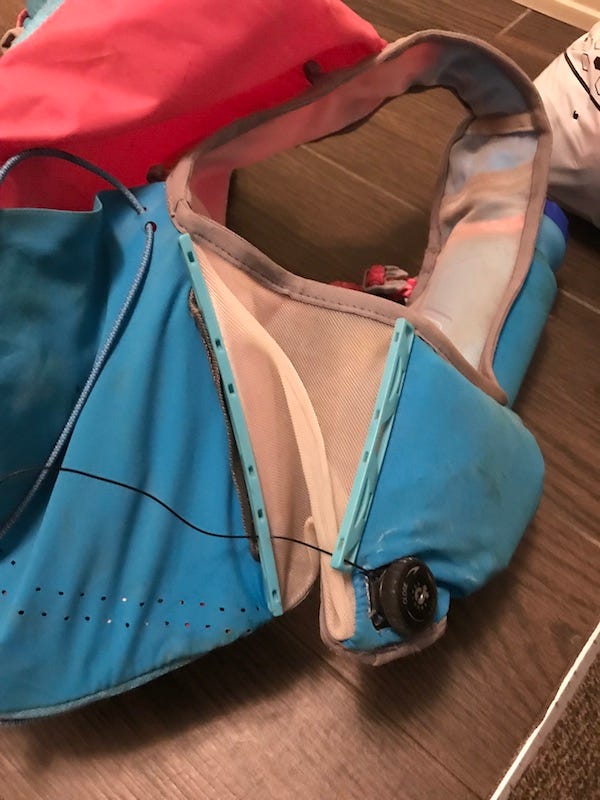
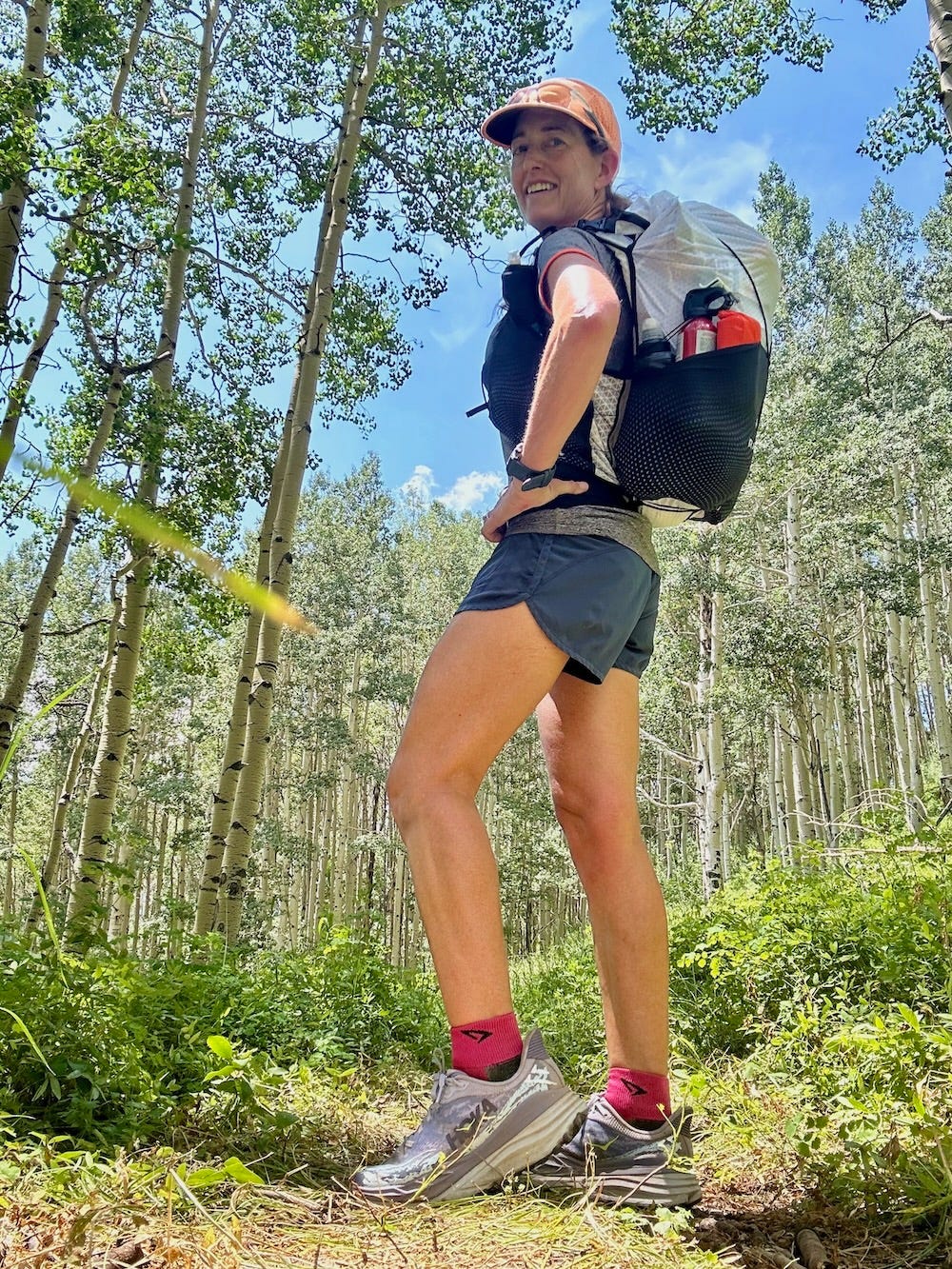
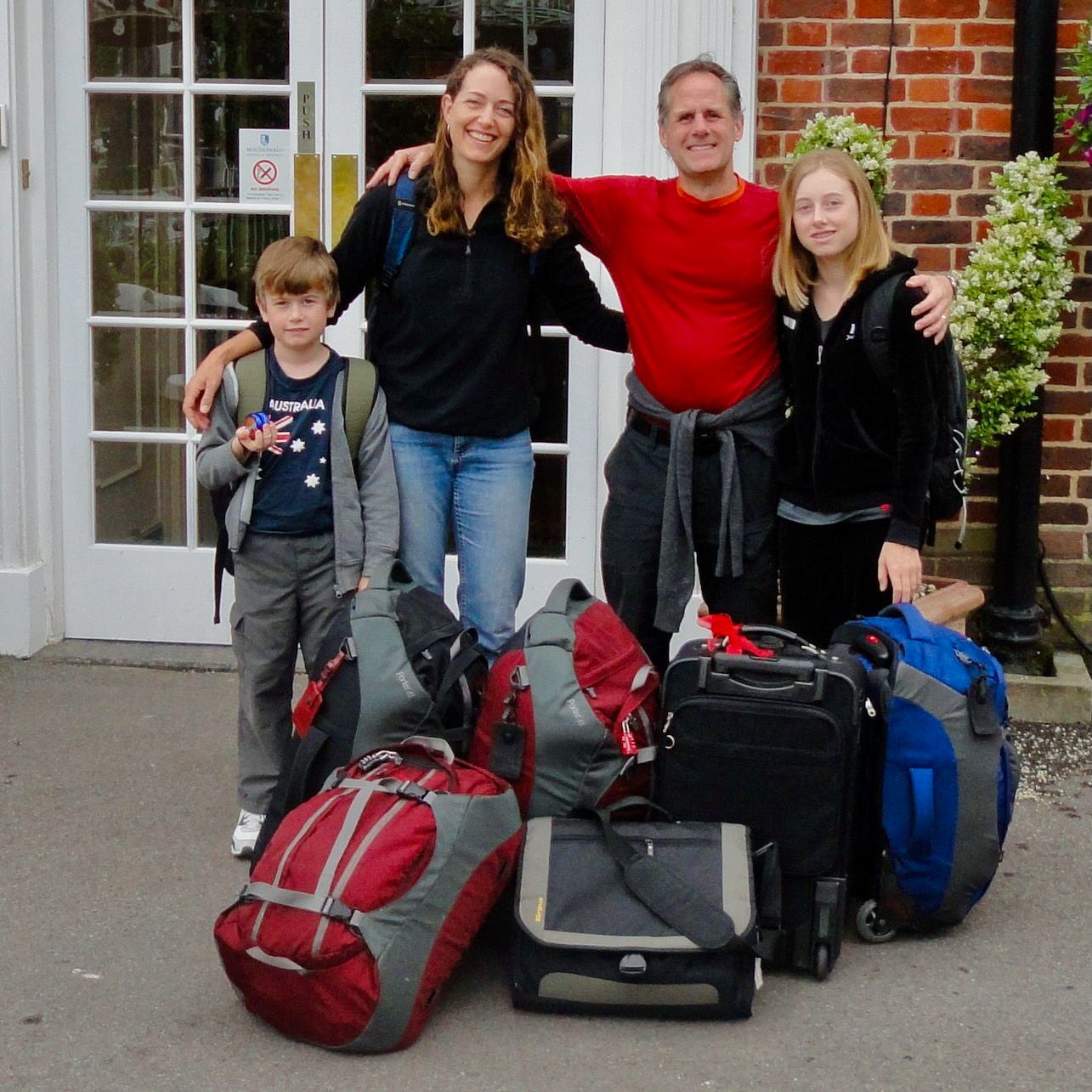

I’d be curious to hear more about what you don’t like about the ultralight packs you’ve tried! Or to be more positive, what you’d like to see more of in the market.
I’m with you on the fascination with a pack—and the activity and experience of packing and carrying enough to be self-sufficient. One of the things I fell in love with about trail running right at the start was, I confess, the packs! Granted, I’ve never had to run with the kind of pack weight you’re talking about, but I love going out for a run with a pack full of all the foods and hydration (ha! Now that I’ve learned my lesson!) that I’ll need.
Also thank you so much for the shout out! I’ve noticed some new subscribers today!